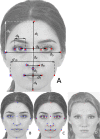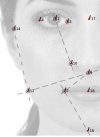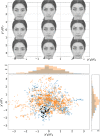Subjectivity and complexity of facial attractiveness
- PMID: 31182736
- PMCID: PMC6557895
- DOI: 10.1038/s41598-019-44655-9
Subjectivity and complexity of facial attractiveness
Abstract
The origin and meaning of facial beauty represent a longstanding puzzle. Despite the profuse literature devoted to facial attractiveness, its very nature, its determinants and the nature of inter-person differences remain controversial issues. Here we tackle such questions proposing a novel experimental approach in which human subjects, instead of rating natural faces, are allowed to efficiently explore the face-space and "sculpt" their favorite variation of a reference facial image. The results reveal that different subjects prefer distinguishable regions of the face-space, highlighting the essential subjectivity of the phenomenon. The different sculpted facial vectors exhibit strong correlations among pairs of facial distances, characterising the underlying universality and complexity of the cognitive processes, and the relative relevance and robustness of the different facial distances.
Conflict of interest statement
The authors declare no competing interests.
Figures





References
-
- Laurentini A, Bottino A. Computer analysis of face beauty: A survey. Computer Vision and Image Understanding. 2014;125:184–199. doi: 10.1016/j.cviu.2014.04.006. - DOI
MeSH terms
LinkOut - more resources
Full Text Sources
Molecular Biology Databases

